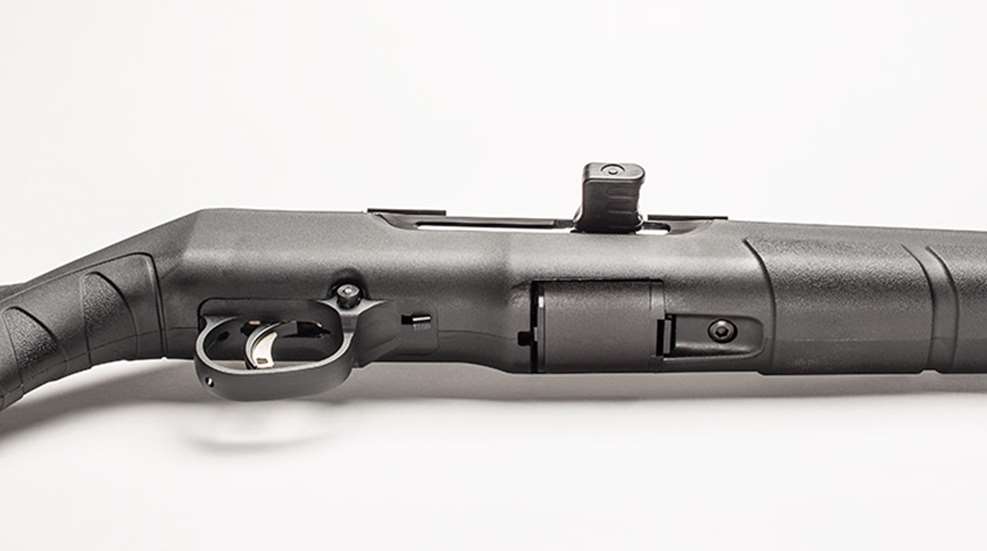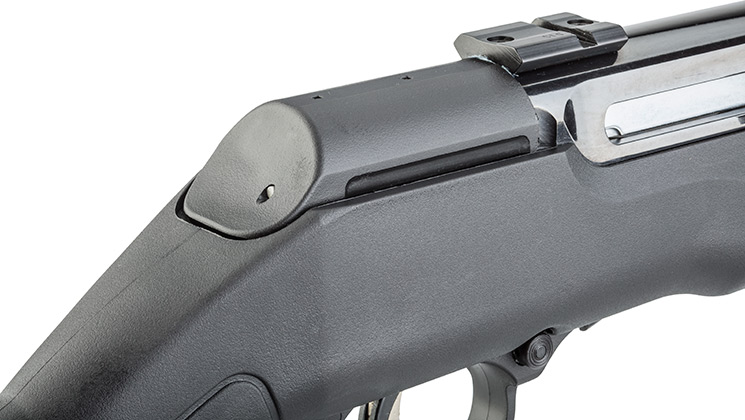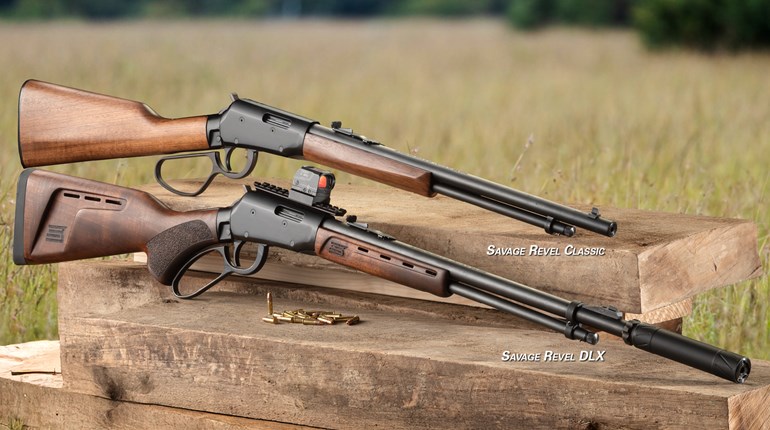
The .17 HMR came out in 2002 and was a huge hit with everybody except the gun manufacturers who tried to make it work in a semi-automatic rifle. They pretty much hated it. The cartridge just didn’t play well with the current rimfire semi-auto rifle designs. Then last year Savage cracked the code and introduced the A17 semi-auto in .17 HMR. I reviewed it and it went on to win the prestigious Golden Bullseye Award from American Hunter for Rifle of the Year.
The .17 HMR cartridge is made by necking down the .22 WMR case to take a .17-caliber bullet. Semi-auto rifle makers hate the .22 Mag., too, and they cuss it when they think nobody is listening. Still, it was only logical that Savage would tackle the .22 Mag. next, and this year the company introduced the A22 Magnum rifle. It is more or less the same well-designed and very successful rifle as the A17, but with a slightly bigger hole through the barrel.
Most issues with the .17 HMR and .22 Mag. in semi-auto rifles relate to the straight-blowback actions typically used in the guns and the design of the rimfire cartridges themselves. Rimfire cases must be made of metal that is thin enough to be dented by the firing pin, and that results in a very weak case. Not a problem as long as the case is supported by the chamber, but it’s a fine line in a blowback semi-auto rifle. If the bolt opens too soon and the case is unsupported while internal pressure is still high, the case can rupture. But if the weight of the bolt is increased to delay opening, the rimfire cartridge often doesn’t have enough power to cycle the action.
Savage solved that problem in the A17 by using a delayed-blowback action, and the company uses the same in the A22 Magnum. A small bar in the hard-chromed bolt slides up to fit into a slot in the receiver when the bolt is closed, locking the action shut. When the gun fires and force builds against the bolt, that locking bar cams out of its receiver groove and down into the bolt, allowing the action to cycle. The bar delays the bolt from opening just long enough to work out the timing for these cartridges to function well in a semi-auto.
Like in the A17, Savage designed the A22 Magnum bolt to have what it calls “dual controlled-round feed.” As the cartridge exits the magazine, the extractor captures the case rim and holds the round in a way similar to a Mauser-type centerfire bolt. There is a “cartridge stabilizer” opposite the extractor on the bolt face that also helps to handle the round. The result is very positive feeding.
The 10-round rotary magazine is interchangeable between the .17 HMR and the .22 Mag., but some of the large-capacity aftermarket magazines in development will be cartridge-specific. A tab on the rear of the magazine fits into a slot in the stock, and a spring-loaded release lever is at the front. The magazine is, as it was with the A17, pretty much my only complaint. Seating it is a pain in the neck, and it’s prone to falling out of the gun if you don’t get it exactly right. The trick is to open the bolt before inserting the magazine. The charging handle is big and prominent so you can work it easily even while wearing gloves, and there is a lever in front of the trigger guard that allows the bolt to be locked to the rear. Once the bolt’s locked open you can seat the magazine with almost always good results. A good smack or two ensures it’s seated. Praying might help; I don’t know. I do know that cussing does not.
The A22 Magnum has a 21-inch button-rifled barrel, which I’m sure contributes to this rimfire’s excellent accuracy. While the rifle wears no sights, the receiver is drilled and tapped for scope bases, which are included. The barreled action has a high-luster black finish.
Savage gives the rifle its famous AccuTrigger, which in my test sample broke at 2 pounds, 4 ounces with a clean, crisp pull. The trigger housing assembly includes a synthetic trigger guard and a cross-bolt safety in front of the trigger. Sliding out a retaining pin allows the assembly to be removed from the receiver for cleaning.
The black synthetic stock has molded-in gripping panels on the fore-end and pistol grip, as well as a rubber buttpad and sling swivel studs. Two action screws hold the stock to the barreled action. Oddly, the back screw fits down, rather than up, and requires removing the scope and the dustcover at the rear of the receiver to disassemble the rifle.
By my memory the A22 Magnum is the most accurate .22 Mag. I have tested and, other than that magazine seating thing, is the most reliable semi-auto in that caliber. I had a few jams early on, but they may have been the result of the magazine being seated incorrectly. Once I figured out the secret to seating the magazine, the rifle ran pretty much trouble-free for the rest of the day. I did the formal accuracy and velocity testing and then ran a couple hundred more rounds through the gun, plinking at rocks at various ranges out well past 100 yards. Then I shot more groups from the bench. I was happy with the results all the way around.
I remember testing a different .22 Mag. rifle years ago with poor results. At the time another gunwriter told me that “.22 Magnums are never accurate.” I didn’t agree then, and today I would hold up this rifle as evidence that he was not only wrong, but also probably in the wrong job, except I have not seen him in years.
Just as with the A17, CCI introduced a cutting-edge .22 Mag. load to coincide with the launch of the new rifle. A22 Magnum ammo uses technological advances in rimfire propellants and bullets to drag this 57-year-old cartridge into the modern age. It was the most accurate ammo I tested, averaging .53 inch for three, three-shot, 50-yard groups. The best group was .20 inch. That said, all the ammo I tried shot very well.
The A22 Magnum rifle is not fussy, and it dispels any myths that the .22 Mag. is not accurate. It also proves, once again, Savage knows how to build a reliable semi-auto magnum rimfire.
Technical Specifications
• Type: semi-automatic rimfire rifle
• Caliber: .22 WMR
• Barrel: 21"; carbon steel; button rifling; 6 grooves, 1:16" RH twist
• Magazine: rotary, detachable box; 10-rnd. capacity
• Trigger: single-stage, user-adjustable Accu-Trigger; 2.25-lb. pull weight
• Sights: none
• Safety: cross-bolt
• Stock: straight-comb, matte-black, injection-molded polymer; LOP 13.75"
• Metal Finish: satin black
• Overall Length: 40.5"
• Weight: 5.5 lbs.
• Accessories: factory-installed scope bases
• MSRP: $473




































